There are many reasons why we may find ourselves in the midst of a power outage. It could be a planned blackout, severe storm, natural disaster, EMP, or accident.
Regardless of the cause, we need to take the appropriate actions to ensure that disruption to our access to electrical power has as little effect on our lives as possible.
While we all know what to do when the lights go out, it is worth mentioning a few things that we should definitely not do.
Open The Fridge Or Freezer Unnecessarily
The food in our refrigerator will stay cold for at least four hours, and your freezer should stay frozen for a day or so.
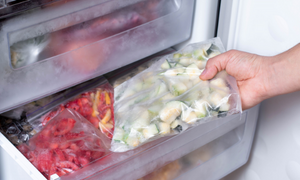 These estimates will only remain true as long as we limit the number of times we open the doors to our fridge and freezer.
These estimates will only remain true as long as we limit the number of times we open the doors to our fridge and freezer.
Each time we crack the seal, cold air is allowed to escape, and without electricity, there is no way to cool it back down.
⇒ What To Do With All Your Frozen Food Once The Power Goes Out
Think carefully each time you open the door and do everything possible to limit the amount of time it is left open.
Drive Around Unnecessarily
If the power outage is widespread, the gas stations will not be able to pump fuel out of the underground tanks.
Like battery power, you are going to have to conserve the gas in your vehicle as well. Any trips you plan to take out of the home must be carefully considered and be absolutely necessary.
Waste Battery Power
A power outage is not the time to try to get a high score on Candy Crush.
 Limit the time devices that run off batteries are turned on and do not use them for any frivolous purpose.
Limit the time devices that run off batteries are turned on and do not use them for any frivolous purpose.
Smartphones, tablets, flashlights, lanterns, and radios should only be used when necessary and for the least amount of time possible.
Smartphones should be turned off when not needed or at least switched to airplane mode to save battery power.
Even if you have battery backups or off-grid power solutions, do not waste battery power on anything that is not essential.
Use Candles
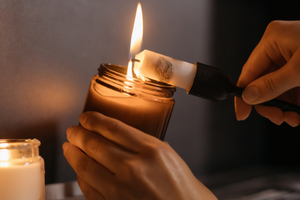 It seems that a power outage would be a perfect time to light the home with candles. Using candles is a good way to light a room without batteries, but it can be dangerous. All it takes is a moment of clumsiness to turn a candle into a house fire. If you choose to use candles, use proper holders that will not tip over.
It seems that a power outage would be a perfect time to light the home with candles. Using candles is a good way to light a room without batteries, but it can be dangerous. All it takes is a moment of clumsiness to turn a candle into a house fire. If you choose to use candles, use proper holders that will not tip over.
Leave All The Lights On
We do not want to leave all our interior and exterior lights turned on when the lights go out. Like with electronics, a power surge could result in these lights being overloaded and burned out.
You should, however, keep one exterior and one interior light turned on so that power crews can see your home has restored power, and you can also tell that power is restored from the inside.
Run A Generator In The Garage
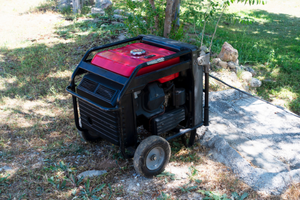 Leaving an expensive generator outside is something that none of us particularly want to do.
Leaving an expensive generator outside is something that none of us particularly want to do.
It is very tempting to move our generators inside the garage to keep them safe from tampering or theft.
Related: DIY Bicycle Generator
Although it is true that the door which leads from the inside of the house to the garage is designed to keep carbon monoxide and other fumes from entering the home, you should never run a generator inside a garage. The fumes will build up inside the garage and find their way into the house.
The problem with carbon monoxide is that it has no taste, color, or smell and causes illness that will lead to death if left untreated.
Use A Barbeque In the House
 For the same reason as running a generator in the garage is a bad idea, you should never use a barbeque indoors.
For the same reason as running a generator in the garage is a bad idea, you should never use a barbeque indoors.
It can be tempting to do, especially in the dead of winter, but the resulting carbon monoxide that will flood the house is deadly.
The same goes for camp stoves or any other stove that burns fuel. The same goes for using a barbeque or fuel-burning stoves in a garage.
Even if the door is open, there is no guarantee that the resulting carbon monoxide build-up will be exhausted from the space.
Leave Electronics Plugged In
If the outage is temporary, the power will eventually be restored. However, when this happens, there will be a momentary surge.
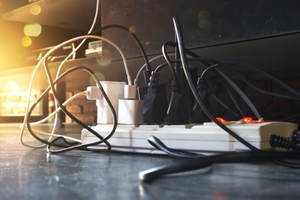
Some electronics are sensitive to surges in power and can be damaged.
Unplug electronics after the power goes out and only plug them back in when the power has been fully restored.
Related: 8+ Devices That Will Survive An EMP
Alternatively, you could use surge protectors for any sensitive electronics, which should insulate them against any power surges resulting from the restored electrical grid.
Touch Downed Wires
It does not matter if the power is out; never touch a downed wire.
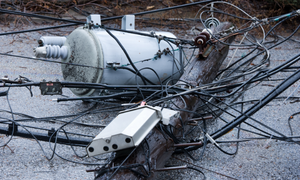
Removing fallen power lines from your property can be tempting, but your home being without power does not mean that the fallen power lines are not still live.
Therefore, give all fallen power lines a wide berth and assume that all downed power lines are still live.
Forget About Your Plumbing
During a power outage, it is not intuitive to think about your plumbing.
However, if the outage occurs during the winter and you lose heating, your pipes become susceptible to freezing and need to be insulated, so they do not freeze and burst.
It is best to do this before an outage, but if the power goes out in the dead of winter, you should assess which pipes may freeze and do your best to insulate them.
Concluding Thoughts
The ever-increasing fragility of our electrical grid will lead to more power disruptions in the near future.
There is also the constant threat of EMP, CME, or even terrorist attacks, which could take down the electrical grid on a grand scale.
Therefore, it is essential that we always take the correct actions each time the power fails to remain safe.
You may also like:
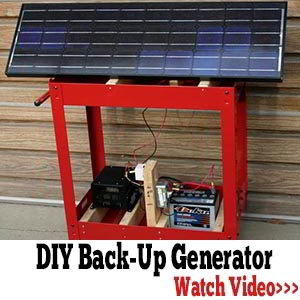 How To Preserve Foods In Honey
How To Preserve Foods In Honey
7 Actions To Take Immediately Following An EMP Strike (Video)
The Plant Doctors Are Begging People To Grow
How To Build A Survival Debris Hut
72 Types Of Americans That Are Considered “Potential Terrorists” In Official Government Documents

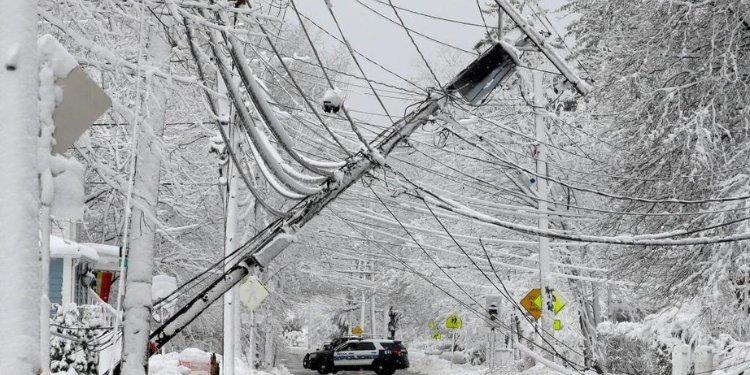













Candles are pretty nice. Plus they put out some heat.
agreed to a limited point >>>
first off – make sure you stockpile UNSCENTED candles – after a while the vanilla or pine scent gets to be too much – especially when the scents combine with each other and the human living scents get involved ….
if you’re going to have open flame lighting like candles or oil lamps – make them fastened down stationary – especially if you have kids & pets involved – use your battery op devices for lighting up your transiting the home …..
candles are a cheap prep – but they may prove very costly if the prep isn’t complete ….
Oil lamps also produce some heat as well as light. Need to make sure they, too, are set safely away from children, animals and clumsy adults.
Above all else, never ever sit next to a naked flame after eating a tin of cold beans and cabbage.
I recall reading a newspaper article in a major city of Florida reporting on a very heavy woman using an outhouse on her property, who lit up a cigarette while sitting on the seat and the built up gasses exploded apart the whole outhouse. You are very correct to mention this; and though I consider it funny I wonder if the two people who voted down just don’t understand the facts that farts are methane gas that is highly explosive and especially in small spaces when one has terrible gut upset (fumes).
That is a very important point radarradar, outhouses are well ventilated for good reason, all the more so when in use in the middle of the night using a lamp or candle for light. Having a cold backside is better than 3rd degree burns. Those of us who were raised rurally usually know the dangers of poor ventilation from our upbringing (fuel stores, battery cabinets, construction, fertiliser, engine exhausts etc), but the city folk used to everything being on tap at the flick of a switch need to learn this stuff as much as any other survival skill.
It’s perfectly okay to use candles for the reasons already mentioned. BUT, please do yourself and your family a favor and use them inside a glass container to collect the wax (which can be used again), AND prune the wicks before lighting them. Most people don’t think to do that, but with a long wick you lose a lot of wax that burns off with soot that sticks to the ceiling and walls.
And strongly recommend you keep a large supply of votive candles to use. Once you light them, let them burn until they burn out. They are designed to do that, not be blown out part way. It diminishes their capability. We use them for an evening dinner party, which means it’s the perfect timing for a family to eat dinner and spend some time together before hitting the sack.
during the ice storm of 2007 we went 11 days without power and i didn’t have a generator yet. i disconnected the water supply lines from the washing machine and up-stairs bathroom then used my air tank and blew out the lines. i got over 5 gallons out of each line(hot and cold). i put a kerosene lantern inside a metal bucket(to prevent tip-over) and put this in the well house which made it toasty in there and prevented frozen pipes or pump. just a couple helpful ideas to think about.
I have a garage that is not attached to my home so I leave my generator in there with the small door open.
Same here Pat, been in the garage forever with a 50 amp cord to the house to an RV plug.
I hope you switch off the main circuit breaker on the house before connecting the generator so you don’t electrocute the poor buggers trying to restore the service or anyone else down the line. You’ll likely find that this is illegal unless you have a properly installed and signed-off cutover switch or a dedicated circuit fully isolated from the mains supply.
If I even had a garage, I would probably arrange an exhaust vent for the genny. Mine is chained to the power drop though. I’ve never yet had to use it.
When the big cold snap came here in Montana the other week, I put my small Honda inverter generator inside the house with some extension cords at the ready. The power was going on and off every few minutes on the negative 40 degree evening due to a failing electrical transformer on the power companies end in town. My plan was to run the generator outside to power the blower motor fan on my propane furnace, the fan on my wood stove, and the little heater for the chicken coop.
That little inverter generator is worth it’s weight in gold. It barely sips fuel, and it’s super quiet. I run the blower motor on my camp trailer with it at night during Elk hunting and it’ll run nonstop for a solid 8 hours on one gallon of gas.
I plan on covering my freezer chests in 2″ foam panels in large plywood boxes that I’m going to construct, with a vent in the “hot” area at the bottom of the lower side where the compressor is. This should buy me a lot of time for keeping the food frozen in the event of a prolonged power outage. In that case, I have mechanical timers that I’ll set to occasionally run them in the warmest part of the days with them being in an insulated garage if we get a prolonged power outage. We have a bunch of solar panels with the inverter, controller and everything else except for batteries that I plan on buying right before I finish building on our property later this next year that will solely be for running the well pump, freezers, and blower fan on the wood stove.
If no candle holder, place candle in a pot or saucepan and ass some water to the pan for both weight (lowers the center of gravity) and as a fire break of sorts.
Wax floats, the candle will tip over and go out.
everything you own is made from china…. The DOD is panicing because most of the military stuff is linked to parts made in china.
There WAS a specific law that forbade US military to outsource outside of the USA or buy assemblies not made from all USA parts. But that got knocked in the head by the Clintons, i think.
If you don’t have candles, make candles from cotton wick material, string even cloth. Pour cooking oil onto some water in a cup, glass, tin can, whatever. Float something on top through which the wick can be above and below the oil at the same time. Light it.
During the blizzard of 93 here in NC we lost power for over a week. AND there was a lightning storm during the snow we got (18 inches in my yard) that is a very unusual thing to have happen during a snow storm. It fried the fridge. I had just bought 2 brand new metal 50 gal trash cans and they were clean so I put all the frozen food in one and refrigerator food in another and then placed them in the snow on the shady side of the house. Al’s put Thermometers in both. They never went above freezing so we didn’t lose ANY food. Outside Temps were the cans sat in the shade never went above about 30 degrees. This little “experiment” saved me a ton of money in food. The power company replaced the fried fridge which I hadn’t expected either. And we had a couple of kerosene heaters and one of those Buddy propane heaters so we also stayed toasty. I had just started into prepping when all this happened so while I wasn’t far into prepping it cinched the whole idea of prepping for me.
No need for candles! A comment on this: I made a candle by filling a mason jar with greenery, cranberries and olive oil. Floated the wick on top. It has worked for over 12 hours now and still going! I am so glad I found these wicks.
https://www.amazon.com/Ner-Mitzvah-Round-Floating-Wicks/product-reviews/B01N0J47AH/ref=cm_cr_getr_d_paging_btm_next_3?ie=UTF8&reviewerType=all_reviews&pageNumber=3
Round Floating Wicks – 200 Count (Approx.), Large Cotton Wicks and Cork Disc Holders for Oil Cups – Bonus Wick Removal Tweezers – by Ner Mitzvah
Visit the Ner Mitzvah Store $16.95 ($0.08 / Item)
Very good article! Covers the basics plus some very well. Plumbing tips. FIRST, if you have a well pump, turn off it’s breaker. The only thing that i would add is this, many houses in the past and some still, have drains at the low points of the supply side plumbing This allows for a house to be fairly rapidly winterized as it drains the vast majority of the water supply lines pretty quickly. I realize that some single-level houses either have only a crawl space and in certain parts of the house NO access to underfloor plumbing and those areas can be difficult to impossible to quickly access. However, if you can access even some of those now, before an emergency hits, and put in a drain or 2, it will save you a mountain of trouble from freezing. One further point to mention, the drain side of things. All sinks, showers, washing machines and toilets have a “trap” in or just below them that holds water all the time and prevents septic gases from entering the home. These will freeze and split if you don’t prep them. It’s Very easy, quick and cheap to prep those. Go to your favorite RV supply, hardware store or auto parts supply and buy about 3 gallons of RV antifreeze, AKA Pink Antifreeze. It’s low cost, non-toxic and works great! Pour about a large coffee cup full of it down each sink and shower drain and forget about it. Toilets i reccommend shutting off water valve to toilet, flush it a couple times to empty it’s water reservoir as much as possible and then pour a quart down each toilet and another coffee cupful into the tank to take care of the leftover water in the tank as the vast majority of toilets do not completely empty the tank when flushed. I keep 3 gallons of RV antifreeze around just for that possible crisis. It’s cheap and it doesn’t go bad. Obviously, the washing machine and water heater need to be prepped too. All water heaters have a drain, and if it was properly installed, a hose hooked to that drain and run into the waste water system somehow. Simply open the drain and all water will drain out. If it isn’t lime or calcium blocked from draining, as does sometimes happen. If you open drain valve and no water or just a tiny trickle comes out, it’s blocked. Keep in mind it will likely be pretty hot water if power failure is recent. SOMETIMES you can unscrew the valve from the tank and take a long drift punch and a hammer and tap a hole through the lime/calcium to get it to drain. Obviously, water is gonna come flooding out with some amount of force, so be ready to screw the valve back in quickly or you’ll end up with a big wet mess. Washing machines ALL have a pump drain plug on the bottom of the pump cavity. However, it’s very difficult to get to w/o pulling the machine out of it’s hole and getting underneath it from the back or bottom which may necessitate flipping it over. Difficult for one able-bodied person to do in well lit conditions. First, turn off the 2 supply water valves behind the washing machine. Generally, they have a red and blue knob or handle, but this isn’t set in stone. Assuming the washer is empty, if not, empty it manually and dip out all water, then pour about a half gallon of RV antifreeze in the bin and another pint to quart down it’s discharge hose on the back of the machine. The discharge hose is usually a long rubber hose that comes from down low on the back of the washer and then up to a 180 degree bent end that tucks into or may be plumbed into a drain pipe. Pour at least a cup or maybe a quart into the rubber discharge hose and into the drain pipe it hooks into as well. If by chance the discharge hose is full of water and you can’t pour any in, flop that discharge hose over onto the ground so you can get all the water out of it as possible. Note that this siphoning action MAY pull most of the water out of the pump cavity as well, but don’t count on it. This will save it from freezing damage. Even if you don’t get a 100% saturation of the pump, that’s still ok because it may well freeze, but not SOLID. It’ll be like a slushy, frozen, but not solid. Solid is what breaks parts. Unless you buy a used one, the pump on a washing machine is most of the cost of a new unit. So worth a lil effort to save. It’s literally a 10 minute job, unless the discharge line is siphon draining, then let it drain until it quits. Usually 10 minutes of additional drain time, more or less due to a few variables. I love my Roper/Whirlpool washer. It has manual controls only. No digital nothing. No smart anything. Thank God. I’ve had it since 2010 or 11 and it’s still going strong. Now, as to the icemaker in your fridge. IF, and it’s a big if, you can get to the back of it pretty good, shut off the lil water valve and unscrew the plastic line nut right at the bottom of the solenoid valve. Usually low and on the left side of the back of the machine. Just follow the plastic line to it. Good news is if you can’t move fridge to get to it and it freezes, you’ll only be replacing a $30-60 valve. It doesn’t hurt the rest of the fridge or affect it’s cooling ability. People forget about those all the time when they remove a fridge from somewhere and it freezes up in storage somewhere. Obviously, be sure the water is turned off to it too in your prep for freezing. Don’t forget yer Coffeemaker! Usually, just flipping them upside down over a sink will get the vast majority of the water out. Might stand em back up and then flip em back upside down a couple more times to get all ya can outta the lines, but that’s about it unless you are going to take it apart. Which i don’t reccommend in the dark or if your’e in a rush at all. Dishwasher, no, i don’t mean yer girlfriend or kids, that thing under the counter that you put dishes in. Basically, the same for it as a washing machine. However, unless you have a portable, roll-around type unit, it’s always built into a counter. If by chance it is a roll-around unit, then the prep is Exactly the same as a washing machine. For the most of us, it’s under the counter and all you can do is shut the water off to it if possible and just pour about a quart of RV antifreeze inside it and let it run into it’s pump as best as possible. Couple notes on shutting off the water to appliances. Most newer ones have or call for some sort of shut-off valve right at the appliance, similar to what most toilets have. However, it can be very difficult to impossible to get to some of these w/o pulling the appliance all or partway out of it’s hole, likely in the dark with, hopefully, a flashlight. Depending on how you’re house is plumbed, all you may be able to do is drain the main lines at the low point drains. Or if you have some sort of plumbing manifold, like a Manabloc or similar, you can drain at least some of it out of the lines at the manifold. Last thought on this topic. Main water shut-off valve. If you are on city/county water and DO NOT have an electric well pump on your property, Just find the main water lines entry point and there will be a large valve of some sort to shut off. I know that some times that is easier said than done especially if you’re not the person that built the house OR if it’s under the house in a crawlspace or worse, can’t be found. If you can’t find it go outside to where the water meter is, pull the lid off and using a meter wrench or a medium-sized crescent wrench (adjustable wrench), reach down and put the wrench on the flats of the valve and turn it 90 degrees. This lil brass valve will be on the inlet side of the meter attached to the incoming/utility/city or county side of the water meter. Try hard to find and shut it off. If it freezes and pipes burst in some place inside your home the supply water will just keep coming and do massive damage or possibly entirely ruin your home. If you do have a well on your property, turn off it’s breaker in your electric breaker box FIRST, before shutting off your main water supply valve. This is Very Important! In fact, if you’re doin a mad dash freeze prep, turn off the breaker for the well pump FIRST, b4 draining anything. This is a critically important step, because if you shut off your main inlet valve and it is located before your pressure switch, as some houses are, when you start draining lines the pressure switch will turn the pump on to refill your pressure tank. If you’ve shut the main inlet valve off the pump will keep on trying to pressure up the system. This will “deadhead” the pump and almost inevitably damage your Very Expensive well pump. Again, if you are on city/county water and do NOT have a well pump, just shut off the main valve. If you have an electric well pump, shut off it’s breaker FIRST.
Oh, i forgot about the pressure tank! It may very well drain on its own when you are draining lines and such. But do drain it too just to be sure. You cannot add anything to it, as in pouring something in, but you can drain it. Usually there’s a drain valve very close to it and if by chance there isn’t you may need to loosen one of the lines going into or out of it. It’s possible that even if you can’t drain it or readily access it that it may suffer no damage from freezing due to fact of it having a bladder inside which will expand some with any freezing water. Don’t recall ever replacing one due to freezing, but draining it by valve or line is the safest bet.
Wow, nice mini-book! Thanks.
Gee wiz! I wish there was some way to print and save the comments! Yours is simply a great one! Thank you very much!
There is on a computer just hight-light the text by clicking on it and then pressing Ctrl/c at same time. This copies the text to your clipboard. Then use a word processor and right click on blank area and select paste and you have the comment.
You can cut & paste it in your phone into notes (iPhone) or whatever androids have & print from note
Possibly screenshot then send to yourself via email? Sure, It will take a while; however, you will have. Or take a picture using your camera phone and email to yourself.
Hope this helps!!
Enjoy your day!
Thanks for the detailed info.
Here in Florida we get power outages….not from butt deep snow but from Hurricanes. Many of us in Florida have FPL (Florida Power and Light) or as I call them Florida Power and Flicker because many times all it takes is a light rain shower and the lights dim and flicker.
LED battery candles, they flicker but put out enough light to see so your not in total dark.
These will last serval nights on a battery and won’t start a fire. Of course have spare alkaline batteries on hand for them and your flashlights.
I keep at least one deep cycle battery handy, fully charged, with an inverter, to run the basics like lights, cell phone charger and laptop. I tested a Interstate Deep Cycle Battery and found that it could last me, if used conservatively, around a week to week and a half.
An open flame has a hazard potential.Accidents can happen.
When the power goes out our go to light source is a dynamo
LED lantern.They can be charged with the hand crank or AAA
batteries or the small solar panel on top.There are four settings
for brightness and the dynamo crank will charge your cell phone.
There is no reason in the age of led lighting anyone should use a candle, kerosene lamp, or propane lighting. Are we cave men? Every piece of old camping gear should be thrown in the trash. I think we can all see the results of using old tech in a modern world ” think Russian military “
Spunk, my Coleman camp stove is over 30 years old, and doesn’t run on LEDs. I’m keeping it, and many other things from “back in the day”. ALL of them STILL WORK as well as some of the new stuff, and yes, I have that as well.
While I don’t have a problem with LED products in general, (I agree they use less power than the older stuff, and can illuminate somewhat more with less power drain) a LOT of what is on the market today doesn’t stand up as well as the old tried and true stuff, much of of which was manufactured with much higher standards. Old camping gear in particular, the very thing you say ought to be tossed.
Candles and propane lighting will work when batteries are long gone, or when it’s too cold for them to be efficient. Kerosene and oil lamps last for almost “forever”, as does the fuel. I have old vegetable oil that works in the oil lamps that is 12 years expired. I wouldn’t use it for cooking, but it lights the kitchen when needed.
Made in china items are cheaper for a reason,,,,,,, even if I were NOT EXTREMELY opposed to giving them more of my money after the 3 recent years of “mistreatment” from them. (not looking to create a new topic of dispute here).
Barbeque is incorrect. The correct spelling is barbecue.
Thanks, that wil save my life
Dreaded. Thanks for the Comment copy advice with Control-C. I had wondered for several years on this site how to do it, even tried email with AAP and got nowhere, except that they did start saving with comments. THIS IS SO HELPFUL TO THOSE OF US WHO LOVE READING and want to copy great ideas of readers here.
Candles? For some people dangerous (same people that need to be protected from themselves generally): teenagers and people who are forgetful, and kiddies that can’t keep their hands off things.
Easiest solutions are jarred candles or votives in deep cups, essentially things that can’t easily fall over. Common sense not to put them near drapery or where flammable items can be knocked into them.